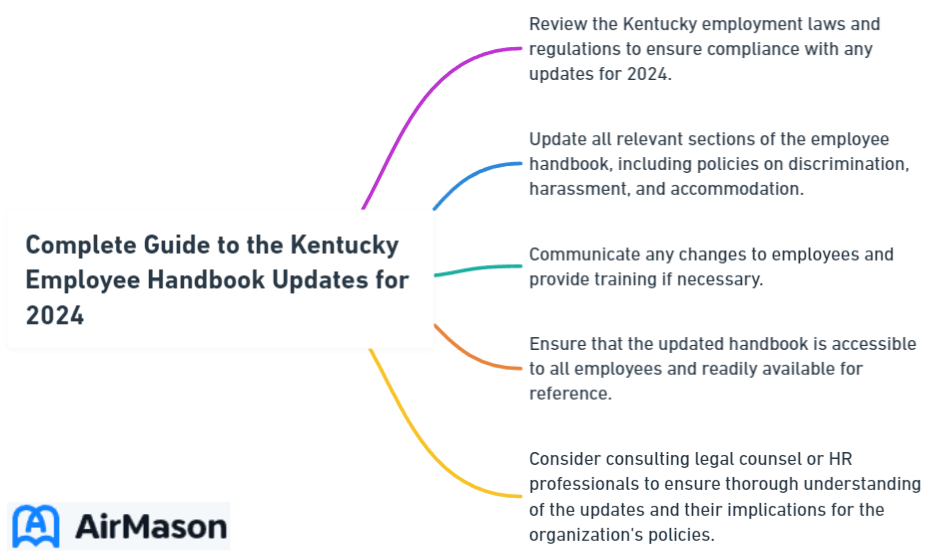
Looking to navigate the complexities of a Kentucky employee handbook? This article is your resource for the essentials of compliance with Kentucky’s employment policies and practices. Get straight to the point guidance on state-mandated policies, the impact of federal laws, and practical steps for crafting a handbook that aligns with the 2024 updates and your organizational culture.
Key Takeaways
- Kentucky employee handbooks must be tailored to align with specific state and federal labor laws, including provisions for Adoption Leave, Jury Duty Leave, and others, to ensure legal compliance and provide clear operational guidance for employees.
- Employers should include essential policies that guarantee compliance, optionally complemented by additional policies to cater to specific industry needs or company culture, and they must stay informed about legislative changes that affect employee handbook requirements.
- A strategic review process, involving thorough legal vetting and cultural evaluation, is imperative for finalizing the employee handbook, ensuring compliance, and promoting a clear understanding among employees through effective distribution, training, and regular updates.
Understanding the Basics of Kentucky Employee Handbooks

An employee handbook is a comprehensive guide, detailing company policies, procedures, and setting forth expectations for employees. It is an essential practice used by prominent Kentucky businesses to align staff members with the company’s standards of conduct and operational guidelines. It’s not just a rule book; it serves as a communication tool that ensures all employees understand what’s expected of them and what they can expect from the company.
What Is an Employee Handbook?
Far from being a simple document, an employee handbook serves as a crucial resource that disseminates company policies, procedures, and expectations to the workforce. It’s like a compass that guides the workforce in the right direction in terms of:
- behavior
- ethics
- rules
- regulations
While it provides a framework for consistency in management and discipline, it also offers a clear path of recourse in case of issues or disputes.

The Importance of a State-Specific Handbook
Unique labor laws and regulations are a characteristic of every state, including Kentucky. Thus, an employee handbook in Kentucky has to be tailored to comply with these state-specific policies. Some of the key policies to include in an employee handbook for Kentucky are:
- Adoption Leave
- Jury Duty Leave
- Meal and Rest Breaks
- Pregnancy Leave
- Volunteer Emergency Service Provider Leave
- Voting Leave
- Workweek and Work Schedules Policy (Day of Rest Law)
In addition, the federal policies such as the Americans with Disabilities Act (ADA) Policy, Equal Employment and Anti-Discrimination Policy, Family Medical Leave Act (FMLA) Policy must be included in any employee handbook. Hence, employers in Kentucky must be aware of both federal and state policies when creating their employee handbooks to ensure compliance and mitigate legal risks.
Setting the Tone for Company Culture
Acting as a strategic HR management tool, the employee handbook articulates the organization’s history, mission, values, and expectations, thereby establishing the company culture’s foundational tone. It’s like the company’s storybook that helps new employees integrate into the company by acquainting them with company values, communication etiquette, and shared goals.
The language used in the handbook should be clear, engaging, and non-authoritative to ensure the communication is welcoming, personable, and aligns with the organizational culture.
Crafting Compliant Policies for Your Kentucky Employee Handbook

With a clear understanding of the employee handbook and its importance, it’s time to create compliant policies for the handbook. It’s like weaving a tapestry, where each thread represents a specific policy that is intertwined with others to form a comprehensive guide.
Your handbook serves as a resource compliant with both Kentucky and federal labor laws, providing a clear roadmap for employees to navigate their way in the workplace.
Essential Policies for Compliance
Essential policies that guarantee compliance with state and federal employment law constitute the backbone of your employee handbook. These policies provide a clear framework for fair and consistent treatment of employees, mitigating legal risks. Kentucky, specifically, mandates seven state-specific policies for businesses, regardless of how many employees they have:
- Adoption Leave
- Jury Duty Leave
- Meal and Rest Breaks
- Pregnancy Leave
- Volunteer Emergency Service Provider Leave
- Voting Leave
- Workweek and Work Schedules Policy (Day of Rest Law)
Additional protection policies specific to Kentucky include provisions for:
- Adoption Leave
- Pregnancy Accommodations
- Emergency Responder Leave
- Voting Leave
- Meal and Rest Breaks
- Jury Duty and Witness Leave
These policies are enforced by the Kentucky Department, ensuring the well-being of employees in the state.
Optional Policies to Consider
In addition to the essential policies, Kentucky employers may consider adding optional policies that cater to specific industry needs or company culture. These other policies, such as an Affinity Group Policy and an Anti-Bribery and Anti-Corruption Policy, can be customized according to the specific needs of their industry. Policies regarding personal conduct and compliance, such as a Social Media Policy and an Anti-Bribery and Anti-Corruption Policy, can promote ethical practices.
Work environment policies like a Health and Safety Policy and a Technology Systems Policy can foster a safe workplace and regulate technology usage. Optional policies serve as a cherry on top of your employee handbook cake, adding extra flavor and depth.
Updating Policies for Multi-State Businesses
For businesses that operate across multiple states, the challenge of crafting an employee handbook increases. They need to consider unique jurisdictional policies when updating their handbooks to ensure they comply with local regulations. Employers should stay informed about statewide legal changes like updates to Paid Sick Leave laws and Workplace Violence Prevention requirements, which could necessitate revisions in their multi-state employee handbooks.
Modification of standard policies is necessary to include state-specific exceptions for the following issues:
- Day of Rest
- Pay Transparency
- Military Leave
- Updates on protected characteristics in EEO and Anti-Discrimination Policies.
What is an Employee Handbook
The question is crucial that what is an employee handbook? Well! An employee handbook is a comprehensive document that outlines the policies, procedures, expectations, and guidelines for employees within an organization. It serves as a valuable resource for both employees and employers, providing clarity on various aspects of employment, including benefits, workplace conduct, disciplinary procedures, and company culture. Essentially, it acts as a roadmap for employees, helping them understand their rights and responsibilities, as well as the overall framework of the organization. Additionally, an employee handbook can help ensure consistency and fairness in the workplace by establishing clear guidelines for behavior and decision-making. Overall, it plays a crucial role in promoting transparency, communication, and accountability within the organization.
Step-by-Step Guide to Creating Your Kentucky Employee Handbook

Creating an employee handbook is comparable to cooking a delicious meal – it involves gathering your ingredients, meticulously following the steps, and adding a pinch of your unique flavor for success. The same applies to creating an employee handbook.
You need to conduct research, write in a clear and engaging manner, and review the document thoroughly before serving it to your employees.
Research and Preparation
Understanding your ingredients is a prerequisite before you commence cooking. Similarly, before creating an employee handbook, you need to conduct research on Kentucky-specific labor laws to ensure compliance and avoid legal risks. Relying on one-size-fits-all templates or copying from other handbooks can lead to non-compliance with state-specific laws and potential copyright violations.
Hence, it’s critical for small businesses to use resources such as the U.S. Small Business Administration’s guidance on crafting employee handbooks to ensure legal and federal requirements are met.
Writing and Language Tips
In cooking, the presentation holds significant importance. Similarly, the language and tone used in your employee handbook matter. The tone should match the everyday work environment of the company, and the language should be concise and free from jargon to ensure comprehension across all employee groups.
Think of your employee handbook as a conversation with your employees. Utilize personal pronouns like ‘you’ and ‘we’ to make the handbook feel personal and accessible, aligning with the company’s culture.
Reviewing and Finalizing Your Handbook
After preparing your meal, tasting and adjusting the flavors is a necessary step. This is similar to the process of reviewing and finalizing your handbook. Legal professionals should review the Kentucky employee handbook to ensure compliance with state and federal employment laws and avoid potential legal liabilities.
A cultural evaluation by leadership or a committee, alongside a thorough legal compliance check, is crucial before finalizing and distributing the updated employee handbook.
Ensuring Accessibility and Understanding

An employee handbook, similar to a recipe, should be easily accessible and understandable. It should be distributed in a format that is easily accessible to all employees, and training should be provided to ensure employees understand the handbook’s content.
Regular updates should also be provided to keep the handbook current and maintain its effectiveness as a legal defense tool.
Distribution and Accessibility
Effective distribution and accessibility are key to the handbook’s effectiveness. The handbook should be provided in either electronic format through an intranet or secure domain, or in hard copy form, ensuring that all staff can access the information.
Whenever the handbook is updated, employers are responsible for notifying all employees and distributing the current information to keep the staff informed and compliant.
Training and Communication
Effective training and communication are instrumental in ensuring that employees comprehend the handbook’s content. Consider splitting the handbook into thematic mini-courses or incorporate videos into training to improve engagement and provide a clearer, more effective communication of the policies.
Interactive training sessions with scenario-based exercises can help in practical understanding and application of company policies, including those related to military service.
Regular Updates and Sign-offs
Similar to software, employee handbooks necessitate regular updates for maintaining their currentness and relevance. Handbooks should be regularly updated to reflect current laws and regulations, ensuring they maintain their effectiveness as a legal defense tool and remain aligned with company mission changes.
Following an update, the revised handbook must be reissued to all employees, and organizations should secure a signed acknowledgment for each employee’s personnel file.
Leveraging Employee Handbooks as a Strategic Business Tool

An employee handbook extends beyond being a mere book of rules, functioning as a strategic business tool. A well-crafted handbook can disseminate the organization’s goals and core values to all employees, aligning the entire workforce with the strategic vision of the company.
Aligning Policies with Business Goals
When policies align with business goals, it steers all employees towards a common destination, akin to a compass. The language and tone used in the handbook should reflect the organization’s values and culture, thus making the handbook a representation of the company’s identity.
Building a Strong Legal Defense
Employee handbooks can serve as a fortress, providing a strong defense against employment disputes. Clearly articulated policies within an employee handbook help demonstrate consistent and fair treatment of employees, which is crucial in litigation or disputes.
Enhancing Employee Engagement
Employee handbooks can serve as a catalyst, boosting employee engagement. Handbooks that emphasize career development and a positive work culture contribute substantially to employee engagement and long-term retention.
The inclusion of a comprehensive overview of policies and benefits promotes transparency and enhances employee trust and engagement.
Wells Fargo Employee Handbook
The Wells Fargo Employee Handbook serves as a comprehensive guide for employees, outlining the company’s policies, procedures, and expectations. As a valuable resource, the Wells Fargo Employee Handbook covers a wide range of topics, including workplace conduct, benefits, and compliance requirements. It provides employees with essential information to navigate their roles effectively and maintain a positive working environment. Additionally, the Wells Fargo Employee Handbook reflects the company’s commitment to fostering a culture of integrity, professionalism, and respect among its workforce.
Summary
In essence, an effective employee handbook is a critical tool for any business, particularly in Kentucky. It sets the tone for the company culture, ensures compliance with state and federal laws, and serves as a strategic business asset. By crafting a well-rounded and comprehensive handbook, businesses can foster a positive and productive work environment, defend against legal disputes, and drive their company towards success.
Frequently Asked Questions
What is the importance of state-specific handbooks?
State-specific handbooks are important as they ensure compliance with unique state labor laws and regulations, ultimately reducing legal risks for employers.
How can an employee handbook enhance employee engagement?
An employee handbook can enhance employee engagement by clearly articulating company values, promoting transparency, emphasizing career development, and fostering a positive work culture. This can lead to greater satisfaction and retention among employees.
How often should an employee handbook be updated?
It is recommended to update an employee handbook every one to two years to ensure it reflects current laws, regulations, and company policies.
How can optional policies be beneficial in an employee handbook?
Optional policies in an employee handbook can provide tailored support for specific industry needs and company culture, offering additional guidance and depth to the handbook.
How can an employee handbook serve as a strategic business tool?
An employee handbook can serve as a strategic business tool by aligning the entire workforce with the company’s strategic vision and disseminating its goals and core values to all employees.
Important Disclaimer:
Please be aware that the content on this page has been generated by using artificial intelligence language models and may contain errors, inconsistencies, or outdated information. It is provided as-is without any warranties or guarantees of accuracy.
We strongly recommend using this content as a starting point for further research. We disclaim any liability for damages or losses resulting from the use or reliance on this content.